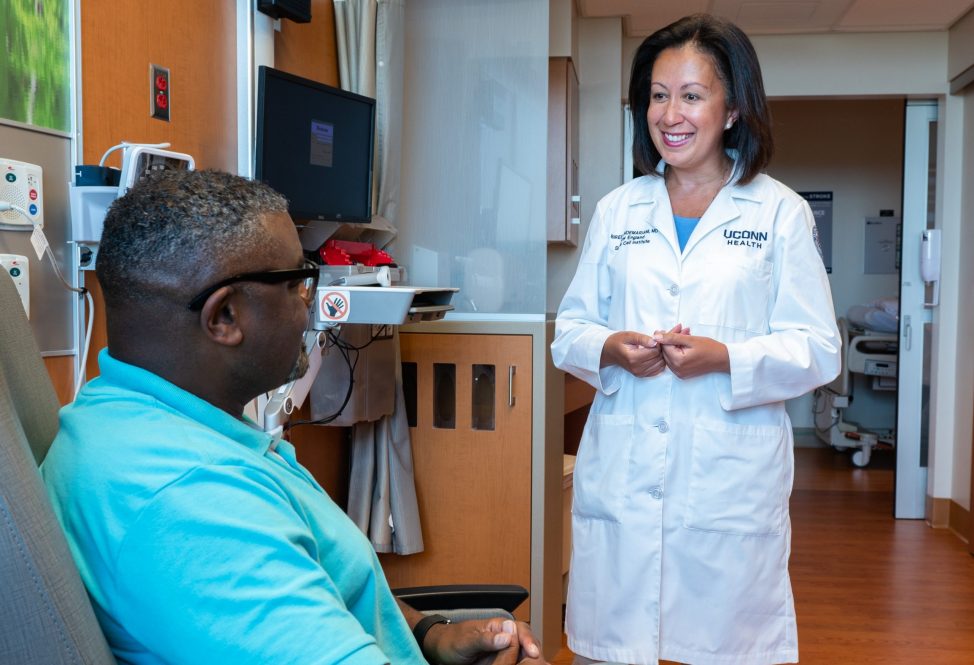The Sickle Cell Disease Treatment Centers Act of 2022 is calling on Congress to expand national funding for Sickle Cell Disease patient care, research, and education.
If the bill is enacted, it would be a dream come true for UConn Health’s Dr. Biree Andemariam, her dedicated New England Sickle Cell Institute, and sickle cell patients across the U.S.
The bill was introduced on Sept. 15, and, if passed in its current form, would authorize for appropriations of $535 million in annual funding to support sickle cell disease (SCD) treatment, research and education.
The new legislation is sponsored by Congresswoman Barbara Lee of California, Congressman Danny Davis of Illinois, Senator Chris Van Hollen of Maryland and Senator Cory Booker of New Jersey. It would create a national network of SCD treatment centers in which healthcare providers and community-based organizations partner to optimize care delivery, including psychological support, while implementing tools that boost education, coping and disease understanding by patients and families. The bill focuses on patient care, with data collection and research as additional positive benefits.
Andemariam is the chairperson of The Council for Sickle Cell Disease Health Equity, an advisory council convened by the biopharmaceutical company Global Blood Therapeutics (GBT). The Council has worked since 2021 as a think tank focused on how to improve the care and life experience of all Americans with sickle cell disease. The Council conceived of the vision to develop a coordinated system of sickle cell treatment centers of excellence around the U.S. that would work side by side with community-based organizations to ensure greater access to essential care.
“The key elements of the Sickle Cell Disease Treatment Centers Act of 2022 are based on a vision developed by a diverse group of stakeholders representing individuals living with sickle cell disease, caregivers, advocates, community-based organizations, physicians, and payers. The introduction and passing of this act have the potential to dramatically improve the lives of individuals living with sickle cell disease across the United States,” said Andemariam, director of the New England Sickle Cell Institute at UConn Health.
Andemariam adds: “The establishment and funding of more than 100 treatment centers would ensure far greater access to quality expert care for those living with sickle cell disease around the country, filling a longstanding inequity and largely ignored gap in the current healthcare landscape for the sickle cell disease community.”
If enacted, the bill will establish a national network of SCD treatment centers based on a hub-and-spoke model connected through national/regional coordinating centers, along with funding for at least 128 treatment centers and 100 community-based organizations or nonprofit entities. The national/regional coordinating centers will facilitate data collection, monitoring and distribution, serve as a repository of best practice guidelines, facilitate publication of research and educational materials, as well as promote public awareness campaigns and other outreach materials that broaden community support.
Leading the Way is Connecticut’s Advancement of Sickle Cell Care
Andemariam has been helping to transform the lives and health outcomes of sickle cell patients in Connecticut and beyond with the advanced clinical care and clinical trial research of the New England Sickle Cell Institute at UConn Health.
Her state-of-the-art Institute is the first and only dedicated outpatient regional center of its kind for managing the painful inherited red blood cell condition. The once small program she founded in 2009 now serves hundreds of patients, and as a national referral base.
Life expectancy for someone born with sickle cell is age 40 or less, but Andemariam’s efforts are helping many beat the odds. Her global collaborations have published evidence-based, best practice guidelines, and her research team is conducting clinical trial testing for promising experimental drugs aimed at reducing the disease’s trademark cell sickling, blood vessel blockages, organ damage, frequent hospitalizations, and premature deaths.
About Sickle Cell Disease
More than 3.5 million are affected worldwide by sickle cell disease, including approximately 100,000 Americans, and in Connecticut, at least 1,000 adults and 600 children. African-Americans and Latinos are predominantly affected in the U.S. Despite the need for consistent and coordinated treatment, few people with SCD have access to multidisciplinary care teams across the U.S. The life expectancy of people with SCD is two to three decades shorter than the rest of the population due, at least in part, to limited access to specialized care.
In the inherited sickle cell disease, a person’s red blood cells are abnormally sickle – or crescent – shaped, which can lead to painful vaso-occlusive crises. This most common sickle cell disease symptom leads patients to experience severe pain due to the development of these blockages in their smaller blood vessels when their abnormally shaped red blood cells cannot pass through smoothly and get stuck. These blockages can also lead to stroke and compromise the health of vital organs, reduce blood flow and cause dangerous blood infections.



